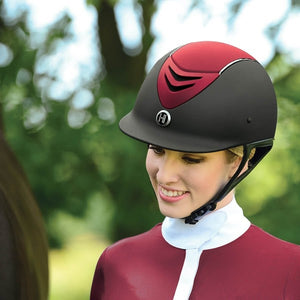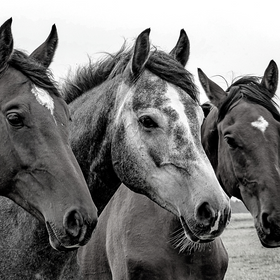
Shoeing Tips for Snow
Winter can bring a special sort of magic to the barn. Between extra time off during the holiday season and stunning snow-covered trails, you may embark on chilly yet exhilarating rides. However, before you hit the snowy trails, it is important to know how the footing will affect your horse. We’ll delve into various shoeing strategies that cater to the specific needs of horses during the winter season when snow and ice create more risks for your horse.
Traditional Snow Pads
One challenge with snow is when it gets packed into the hoof and trapped by the horse shoe. This effectively creates an ice skate for your horse, causing them to slip or strain their legs. Traditional snow pads made from rubber or leather are a reliable solution for horses traversing deep snow. These pads, placed between the shoe and the hoof, prevent snow from packing and accumulating. In tandem with appropriate winter shoes, snow pads protect against discomfort caused by snowballs forming in the hooves.
Rim Pads for Traction
Rim pads are a strategic choice for enhancing traction on slippery surfaces. These pads feature a raised rim that surrounds the outer edge of the shoe, providing additional grip on icy and snowy trails. This added traction minimizes the risk of slips, offering stability and confidence to you and your horse during winter rides.
Borium-Tipped Shoes
When tackling icy terrains, borium-tipped shoes come to the rescue. Borium is a hard metal alloy that can be applied to the horseshoe for increased durability and traction. Farriers strategically place borium on the shoe, creating reliable traction points that grip icy surfaces effectively. This technique is particularly beneficial for horses navigating trails with patches of frozen ground.
Winter Traction Devices
Innovative winter traction devices, such as ice studs or screw-in studs, provide customizable solutions for adapting to varying winter conditions. These small, threaded studs can be screwed into the horseshoe, offering an adjustable level of traction. This allows you to tailor the shoe to your horse's specific needs and the type of ride you want.
Natural Barefooting with Hoof Boots
For some horses, a natural approach to winter shoeing involves going barefoot while using hoof boots for protection. Hoof boots offer a flexible and comfortable alternative to traditional shoes, providing support and protection without compromising the natural movement of the hoof. This works well for horses in areas with moderate snowfall and well-maintained trails.
Thermal Shoeing for Insulation
Maintaining proper hoof temperature is crucial in the winter. Thermal shoeing involves using materials with insulating properties to shield the hooves from extreme cold. Consider shoes made from neoprene or specialized thermal pads that provide an extra layer of insulation, keeping your horse's hooves warm and comfortable in freezing temperatures.
Winter riding can be an experience when your horse is equipped with the right shoes. From traditional snow pads to innovative traction devices, you can tailor your horse's winter footwear to the specific challenges of snowy trails. Collaborate with your farrier to choose the most suitable shoeing technique so that your equine companion can have a safe and enjoyable winter journey!





